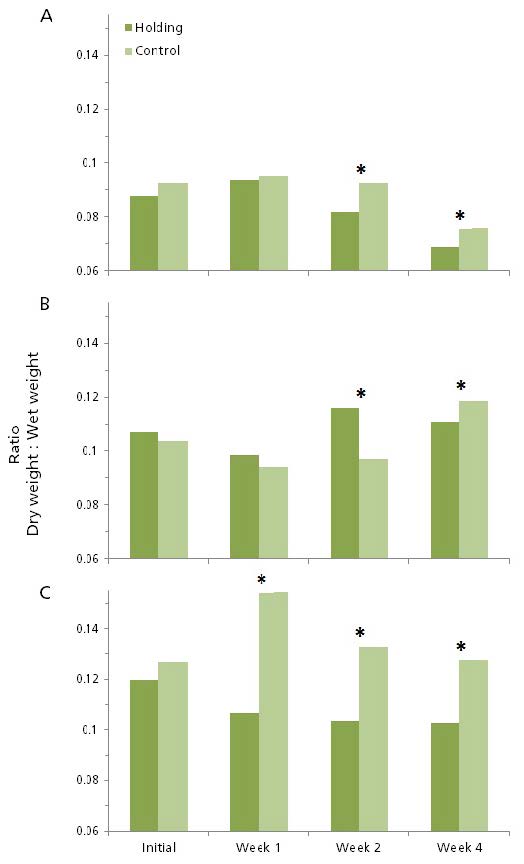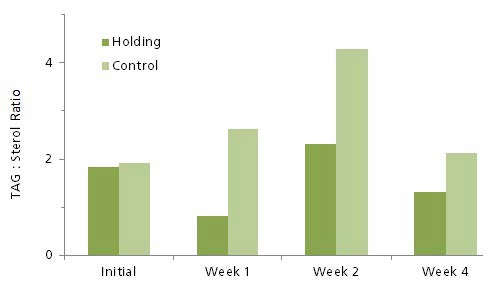Aquaculture Collaborative Research and Development Program (ACRDP) Fact Sheet
Issue 24 - March, 2017
Summary

Figure 1
Blue Mussel (Mytilus edulis).
This study assessed the physiological condition of cultured Blue Mussels (Mytilus edulis) held in a commercial wet storage facility under ambient environmental conditions. Newfoundland harvested mussels were held for one month each in fall, winter and spring and sampled weekly under industry standard conditions. Held mussels were compared directly with freshly harvested samples taken at the same point in time. Changes in biochemical composition (i.e., lipid, fatty acid, glycogen content) and quality (i.e., taste, palatability) were compared between the held and freshly harvested mussels. Results showed that while mussel condition was reduced after four weeks holding, biochemical composition was affected only by seasonality and not by holding conditions. Taste panellists were unable to differentiate between freshly harvested mussels and those kept in holding.
The Aquaculture Collaborative Research and Development Program (ACRDP) is a Fisheries and Oceans Canada (DFO) initiative to increase the level of collaborative research and development activity between the aquaculture industry and DFO. Research and development projects under ACRDP seek to improve aquaculture environmental performance and support optimal fish health.
Introduction
Blue Mussel (Mytilus edulis) (Figure 1) culture is continuing to grow as an industry in eastern Canada and there is increased market demand for fresh product, not just during peak seasons, but throughout the year. Consistently meeting this demand, particularly when weather hampers harvest or transport, can be challenging to growers. Consequently, wet storage facilities have become invaluable tools which allow the industry to maintain supply of their product through weather delays, or stockpile their harvest for anticipated orders.
These holding facilities, however, are often not equipped with environmental controls and rely on ambient conditions to maintain live mussels for extended periods of time. Natural seasonal variations in temperature, food availability and reproductive effort can cause changes in meat yield and product quality during extended storage periods. Previous studies have shown that mussels often display a metabolic response to seasonal variations in ambient conditions (e.g., ammonia secretion, decreased dry weight, meat yield, condition) which have the potential 2 to affect meat quality and market value. However, the effects of extended holding by processing facilities on the biochemical composition of mussel tissue (i.e., lipid, fatty acid, glycogen content) and meat quality (i.e., taste, palatability) remains largely unknown.
This research project aimed to investigate: 1) how seasonality affected variations in the biochemical composition of Blue Mussels; 2) if changes occurred in the lipid, fatty acid, and glycogen composition of mussels held over extended periods; and, 3) if meat quality changed following an extended holding period.

Figure 2
Biochemical composition analysis of mussel samples. (Photo: H. Murray, DFO)Methods
Mussels were collected from a site in Bulley’s Cove, Newfoundland and Labrador, and transported to a commercial processing facility. At the beginning of each season (i.e., fall 2011, winter 2012, spring 2012) unprocessed mussels were placed in two 1,000 L holding tanks at an industry standard stocking density of 0.36 kg/L. Ambient environmental conditions were maintained by continually flowing water from the bay through the mussel tanks. During each season, mussels were randomly sampled from the tanks at the beginning, and after 1, 2 and 4 weeks of holding. Simultaneously, a similar sample of freshly harvested mussels was taken from the same commercial grow-out site, as a field control.
Condition of mussels
In order to analyze the condition of the mussels, 150 individuals were sampled from holding and field control groups at each time point. For each individual, the weight and size (i.e., length, depth, width) was measured. Meat was carefully dissected and dried to a constant weight for 48 - 72 hours at 80°C while shells were allowed to air dry for the same time period. Dry weights were then measured and the condition index was calculated as the ratio of dry tissue weight to wet tissue weight.
Biochemical composition
Ten mussels were sampled from both holding and field control groups at each time point, to measure lipid content and fatty acid composition (Figure 2). Lipid content was analyzed using a modified Folch method (Parrish, 1999). Lipid classes were determined by Thin Layer Chromatography (TLC). Fatty acid composition was determined utilizing a modified method (Parrish, 1999). For the glycogen analysis, 10 additional mussels were taken from both holding and field control groups and the glycogen concentration for each sample was calculated based on comparison with a mussel glycogen standard.
Mussel taste and palatability
To evaluate if extended holding affected the taste and palatability of mussels, 200 mussels from both holding and field control groups were selected and transported on ice to the testing facility. Mussels were steamed for 10 minutes, shucked, and placed in randomly numbered food cups. A sensory evaluation of the mussels was conducted by 24 untrained panellists.
To determine if there was any difference between the fresh and stored mussels, a triangle test (i.e., a test used to determine if a difference exists between two products) was conducted. Panellists were presented with three randomly numbered cups containing two holding and one control mussel, or two control mussels and one holding mussel. The panellists were asked to choose which sample was different from the other two.
To test the overall quality of the product, a hedonic test (i.e., a test that gauges the acceptance and satisfaction with a product based on a list of attributes) was conducted. Panellists were presented with two randomly numbered cups, one of which contained mussels from the holding group and one of which contained mussels from the control group. The panellists were asked to evaluate both samples separately for appearance, odour, texture and flavour using a 7-point scale.
Results / Discussion
Condition of mussels
The condition analysis showed that in the fall and spring experiments, the wet tissue weight in held mussels increased over time, which resulted in a decline in the dry weight : wet weight ratio over the four week holding period (Figure 3). This decrease in the ratio indicates a change in the energy balance of the animal and suggests the increase in tissue water content is related to depleted energy reserves (Lucas and Beninger, 1985). The condition of the held mussels declined after two weeks in the fall and after one week during spring. Conversely, mussels held in the winter showed a slight increase in condition at the end of the trial (4 weeks). Holding during the winter season may therefore present more stable environmental conditions and lower physiological stress. Significant differences between the condition of held and control mussels were observed within the fall at 2 and 4 weeks, during the winter at 2 and 4 weeks and during the spring at 1, 2 and 4 weeks (Figure 3). Of these differences, only during the 2 week sampling point in the winter season did held mussels present a significantly higher condition than control mussels. This marked difference may be a result of a sampling error, as during the 2 week sample, the control mussels were harvested from the wrong line, which contained mussels of a lower grading size.
Biochemical composition

Figure 3
Dry weight : wet weight ratio of mussels observed as part of the condition analysis. A: Fall 2011, B: Winter 2012, C: Spring 2012. Asterisks represent a significant difference in mussel condition between held and control mussels.Mussels kept in holding for 4 weeks presented a total lipid content that was comparable and often higher than control mussels during the fall and winter experiments, suggesting good metabolic balance and nutritional level. In contrast, during the spring season, lipid levels were observed to be the lowest of the three seasons examined and the lipid content of held mussels declined at 4 weeks. The same general pattern was observed when examining specific lipid classes with the triacylglycerol (TAG) : sterol ratio of held mussels being consistently lower than control mussels in spring (Figure 4). This suggests that after 4 weeks of spring holding, mussels experienced conditions of metabolic stress, possibly attributable to increasing water temperature and holding density effects.
No substantial difference between held and control mussels was observed in relation to fatty acid content. Some seasonal variation in the proportions of omega-3 fatty acids was noted in held mussels; however, this may be due to a difference in phytoplankton content between the field site and the area of the bay from which the water supply for the holding tanks was obtained. Glycogen levels were comparable between held and field control mussels, with the exception of mussels sampled at 2 weeks during the fall and at 1 week during the spring experiment, which showed lower glycogen content in the held mussels. This observed difference in the fall may be due to a temporary water shut-down of approximately 24 hours in the holding facility, during which time the mussels may have used internal reserves of stored energy. Overall, mussels sampled in the spring presented the highest glycogen concentration for both holding and field controls.

Figure 4
Triacylglycerols (TAG) : sterol ratio of held and control mussels in spring 2012 (n=10).Mussel quality
At all time points, the results of the triangle test were not statistically significant and showed that there was no difference in quality or taste between mussels held for up to one month and mussels directly harvested in the field.
Results of hedonic tests conducted for all three seasons showed that appearance, odour, texture and flavour of mussels kept in holding and field controls were highly similar. Held mussels scored significantly higher than control mussels for odour (1 week, fall) and flavour (2 weeks, winter). At all other time points tested, there was no significant difference between held and control mussels.
Based on the taste panel response, the quality parameters of mussels held for up to one month under ambient conditions did not change significantly over the holding period, when compared directly to field controls and no seasonal effect was detected.
Conclusions
During the fall and spring seasons both mussel condition and the TAG : sterol ratio showed some evidence of physiological stress response in mussels stored for up to one month. However, these changes were not observed to have a significant effect on the quality of the product when compared to field controls. Season appears to be the most important factor affecting the quality of mussels stored in ambient facilities. As the results of this research apply to a single facility, the design of holding and storage facilities may need to vary depending on the needs of the industry and the environmental conditions of the region. Holding facilities equipped with recirculating systems or environmental controls should be monitored in order to consistently maintain optimum product quality. Future studies could further the knowledge gained through this research by comparing the variation in biochemical and quality parameters observed in the present study with those from mussels held in an environmentally controlled facility.
References
Lucas, A. and P.G. Beninger. 1985. Aquaculture 44:
187–200.
Parrish, C.C. 1999. In: Lipids in Freshwater Ecosystems.
Springer-Verlag. p. 4-20.
This ACRDP project (N-11-02-004) is a collaborative effort between Fisheries and Oceans Canada (DFO) and Norlantic Processors Ltd. The lead scientist on this project, Dr. Harry Murray, can be contacted at Harry.Murray@dfo-mpo.gc.ca
For further information on these and other ACRDP projects.
Published by:
Aquaculture, Biotechnology, and
Aquatic Animal Health Science Branch,
Ottawa, Ontario, K1A 0E6
©Her Majesty the Queen in Right of Canada 2017.
DFO/2017-1992
Cat No.: Fs48-2/24-2017E-PDF
ISSN: 1919-6806 (Print)
ISSN: 1919-6814 (Online)
ISBN: 978-0-660-07643-0
French version and alternative formats available through: Programme coopératif de recherche et développement en aquaculture (PCRDA)
- Date modified: